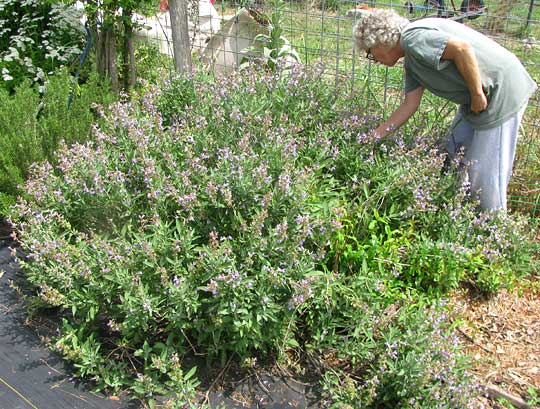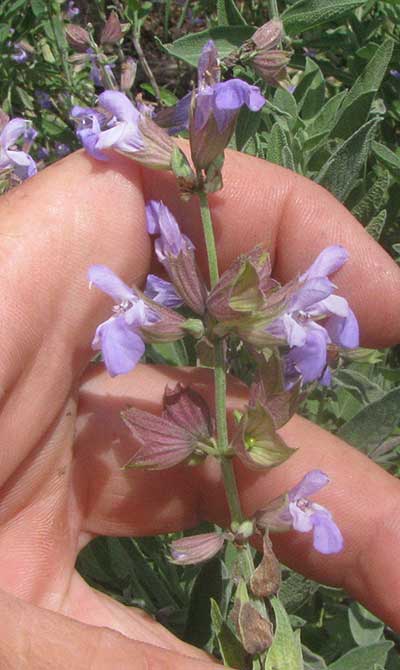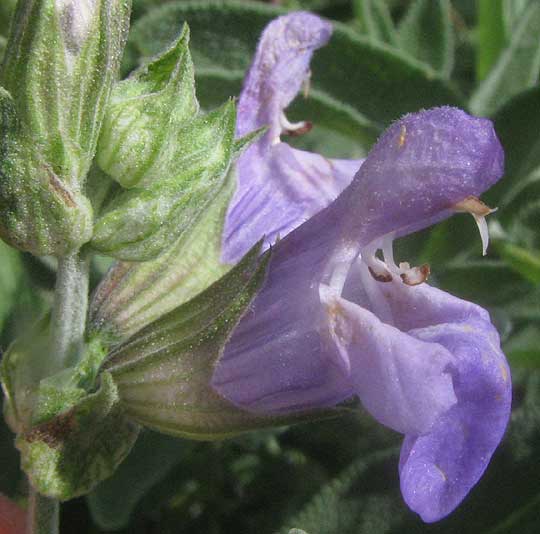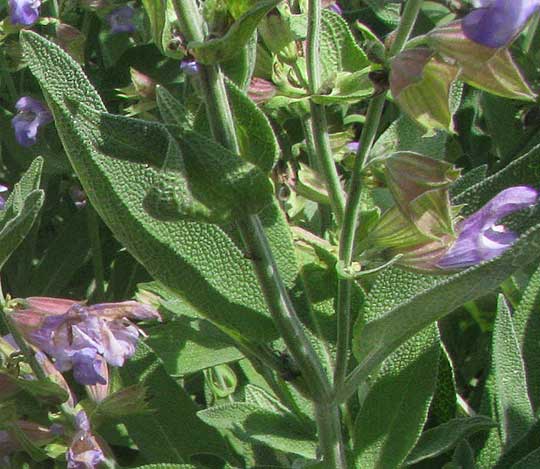Excerpts from Jim Conrad's
Naturalist Newsletter
from the June 2, 2013 Newsletter issued from the Frio Canyon Nature Education Center in northern Uvalde County, southwestern Texas, on the southern border of the Edwards Plateau; elevation ~1750m (~5750 ft); N29.62°, W99.86°; USA
GARDEN SAGE
My neighbor Deborah told me that her big sage plant was in full bloom so I figured I needed to see that. Below, Deborah is seen weeding from around the big bouquet:

Up close you can see that sage flowers are arranged in whorls, or "verticels," stacked atop one another at branch tips, as shown below:

Sage flowers bear two fertile stamens and a style that arch forward beneath the corolla's ceiling. As such they stand ready for a pollinator to land on the corolla's lower lip and plunge into the flower's throat, depositing pollen on the stigma while doing so, and gathering new pollen from the anthers. Below you can see how the pollinator must brush the stigma and anther to enter the flower:

Sages belong to the Mint Family genus Salvia, and Salvia is the largest genus in this big family, with 700-900 known species. Since so many sage species have come into cultivation, and the horticultural world has hybridized between so many species, I figured I might have a hard time identifying Deborah's garden sage. Therefore I made sure to get a leaf picture, which shows this plant's leaves as green (those of many species are woolly white), with leaf margins that are neither lobed or toothed, and with a leaf surface that is very wrinkled, or "rugose," as shown below:

After lots of "doing the botany," I just couldn't get a perfect fit for Deborah's sage with any of the standard species, though it seems to come closest to the European Salvia pratensis, sometimes called the Meadow Sage. But Meadow Sages normally produce broader leaves, especially at the bottom, than Deborah's plant. My guess is that Deborah's sage is a hybrid with a good bit of Salvia pratensis in it.
In the end, it doesn't really matter what species Deborah's sage is, for we both stood a good while next to it simply being in awe of its robust prettiness, and all the pollinators it was providing with nectar and pollen. Also, we both knew to honor the fact that sage has a long history of both culinary and medicinal use.
When I was a kid back on the farm in Kentucky, at hog-killing time we ground sage into the sausage we made from various of our hogs' body parts. Later when I became a vegetarian I was delighted to find how good sage tastes in cornbread.
NaturalNews.com's sage page begins with the statement that "Of all the culinary herbs, sage is perhaps the one with the broadest range of medicinal uses." It then continues by declaring that sage is anti-hypertensive, anti-diabetic, anti-inflammatory and anti-microbial; plus it helps cleanse your blood and may even prevent Alzheimer's disease. And that's just the beginning of the claims made. You can browse through them yourself at http://www.naturalnews.com/027520_sage_herb.html.
A certain part of the sage-appreciating world focuses on its ability to enhance a person's "grounding and presence" -- to calm you down and help you see things more clearly and intensely.
I don't know about any of that, but I do know that on a hot, sunny afternoon watching a healthy plant like Deborah's sage so lustily photosynthesize, gush out oxygen for us all to use, as it pleases so many different pollinators... is a real hoot.